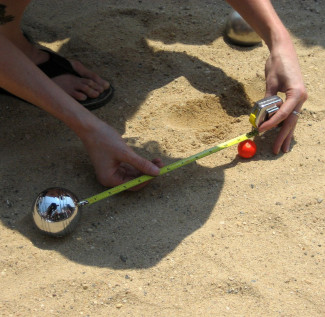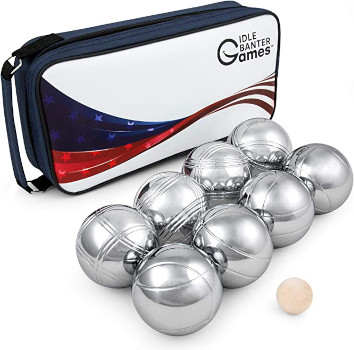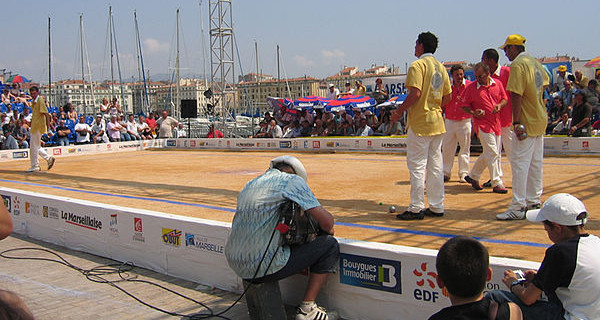
The Game Petanque
Petanque is a French throwing game
Petanque (French pronunciation: [petɑ̃k]) is a throwing game with characteristics similar to games like bowling, Mölkky and kubb. Petanque falls into the category of boules sports, where players throw their balls (i.e. boules) towards a target ball. The word petanque is derived from the expression pè tancat in the Provençal dialect of the Occitan language, meaning feet anchored. The objective of the game is to score points by having balls closer to a small target ball than the opponent after all balls have been thrown.
Everyone can enjoy petanque. It takes only a few minutes to grasp and requires little equipment and infrastructure. The game is normally played on hard dirt or gravel, but can also be played on grass, sand or other surfaces. Petanque is played by two teams, where each team consists of one, two, or three players. Playing a game of petanque requires both skill and precision, but also a strategical mindset!
Boules games have a very long history, dating back to ancient Greece. Petanque in its current form was invented in 1907 in La Ciotat near Marseille. It gained widespread popularity after World War II.
A Brief History

As early as the 6th century BC, the Ancient Greeks were playing games of tossing coins, then flat stones, and later stone balls — trying to have them go as far as possible. The Ancient Romans modified the game by adding a target to throw at, thereby making it more of a game of skill. After the Romans, the stone balls were replaced by wooden balls. Throughout the Middle Ages, the popularity of ball games periodically waned. But in certain regions such as Provence in France, it remained popular.
In the second half of the 19th century, a form of jeu de boules known as jeu provençal became extremely popular in France. In this game, players had to run three steps before throwing a ball. In 1907 in La Ciotat (near Marseille), this rule was adapted for the sake of an old rheumatic man (Jules Lenoir), who could no longer make this run. According to the new rules, the pitcher had to stay in place, which was enforced by drawing a circle around him. They called the game pieds tanqués, feet anchored, a name that eventually evolved into the game's current name, petanque. Petanque quickly became the most popular form of jeu de boules.
Initially, petanque balls were made from wood. To give these wooden balls more weight, they were usually covered with metal nails. After World War I, cannonball manufacturing technology was adapted to create metal balls. Nowadays, petanque balls are manufactured by stamping two steel blanks into hemispheres, which are then welded together to create the hollow metal petanque balls we are familiar with today.
A Global Success
After booming in the South of France at the start of the 20th century, petanque has now become a global success. From World War II onwards, petanque began an impressive advance that at first engulfed all of France, and soon included other countries from Europe and beyond. The many tourists that discovered petanque in France began to import it into their own regions. Petanque is also played in the former French colonies like Laos, Thailand, Vietnam, Cambodia, India and some parts of Africa. Petanque tournaments are played all over the world.
Petanque associations exist not only in France, but also in Belgium, Germany, Switzerland, Spain, as well as in the US, Canada and other countries. The Fédération Internationale de Petanque et Jeu Provençal (FIPJP) saw the light of day in 1958. In 1959, they organized the first petanque World Championship. Today, FIPJP has about 600.000 members in 52 countries and counting.
Petanque is not yet an Olympic sport. With the purpose of lobbying the Olympic committee, the Confédération Mondiale des Sports de Boules (CMSB) was created. Ever since 1985, the CMSB continues to represent its application to make petanque part of the summer Olympics.
Where to Buy?

If you're looking to buy a petanque set, we recommend the one featured on Amazon.
It’s the most affordable option that still meets official FIPJP standards for size and weight — great if you’re just getting into petanque or want to get started with an affordable set.
Heads up: the following link is an affiliate link. If you take action (i.e. make a purchase) after clicking it, we'll earn some coffee money. You do not pay a higher price.
view on amazon.comGame Rules

Petanque is played between two teams. The objective is to score points by having balls closer to a small target ball — the jack — than the opponent. The ball nearest to the jack is said to be holding the point. The team that is not holding the point throw their balls until they place a ball closer to the jack, thereby triggering the other team to throw their balls until they are again holding the point, etc... A round of petanque ends when both teams have thrown all their balls.
The team whose best ball is closest to the jack at the end of the round, wins the round. They get one point for each ball that is closer to the jack than the losing team’s best ball. A game of petanque is played over multiple rounds. The winner is the first team to reach 13 points.
Petanque Tournaments
The FIPJP world championships and the Masters de Petanque, the Europetanque and the British Open Petanque Championships. Year in year out, a great many petanque tournaments are played all over the world. For professional players in associations, or laid-back players with no further aspirations. There are tournaments organized to suit everyone’s taste, so don’t be afraid to sign up for a tournament near you.
International Championships
In 1959, the FIPJP organized the first petanque World Championship. And ever since 1971, they’ve been organizing this event yearly without interruption. Men's championships are held in even-numbered years, while Women's and Youth championships are held in odd-numbered years. Over the years, France has proven to be the best performing country by far.
The European Petanque Championships, also called Europetanque, is organized by the Confédération Européenne de Petanque (CEP) and the federations of its member countries. There are competitions for five player groups: Youth (under 18), Up-and-coming (Espoirs, under 23), Women, Men, and Veteran (over 55).
The Petanque Masters is another international competition, contested by teams in triplets. It takes place throughout the summer in eight stages, across eight French towns. It’s one of the toughest petanque championships in the world.
National Championships
Petanque is enormously popular in France, and therefore most of the tournament action is taking place over there. The Mondial la Marseillaise à Petanque is the largest petanque competition in the world. Open to all, it brings together more than 13.000 players and 150.000 spectators every year in Marseille.
The largest annual tournament in the United States is the Petanque Amelia Island Open (formerly the Petanque America Open), held in November at Amelia Island, Florida. The British Open is a major Petanque tournament in the North of England which attracts players from across the United Kingdom and Europe. Needless to say, many other petanque tournaments are taking place all over the world.





